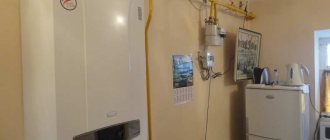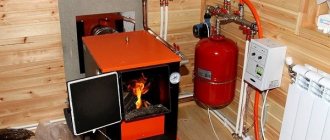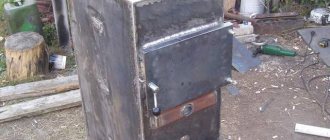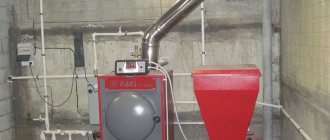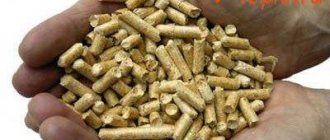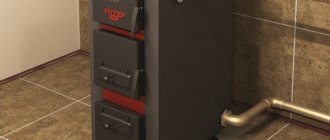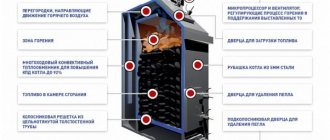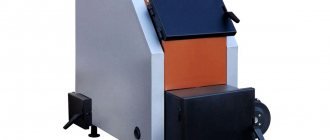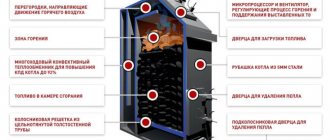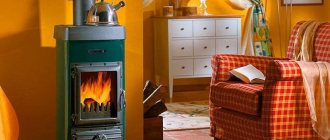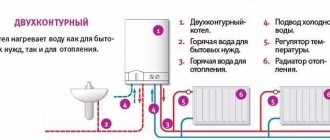The production of Pelletron pellet burners is located in the village of Verkhnyaya Pyshma, Sverdlovsk region. The central office is in the city of Yekaterinburg.
In addition to pellet burners, since 2014 the company began producing ready-made Pelletron pellet boilers with a capacity of 15 and 30 kW. For now, only these two modifications are available. The same Pelletron pellet burners are installed on the boilers. We will tell you about the boilers a little later, when we have enough feedback from users.
In the meantime, a little more about Pelletron pellet burners (using the example of the Pelletron 15 burner) - characteristics (see tables):
general description
Pellets are small granules of plant origin. They consist of ground, compressed remains of wood, bark, corn, straw, sunflower, and other plants. The average length of one is about 4 cm. This type of heating material is environmentally friendly and hypoallergenic.
Pellets burn more efficiently, more productively, and safer, since they cannot self-ignite.
On a note! If we compare different fuels in terms of efficiency, then for wood it is about 37%, for natural gas - 85%, for pellets - over 90%.
To burn such material you need a special burner. Pelletron pellet boilers are based on a special model. This is a unique development of the enterprise, which has a long service life and high reliability. It is made of stainless, heat-resistant materials.
Pelletron pellet boilers are available in different capacities and are capable of heating rooms of different sizes. Their hoppers are located on the side, which ensures simple, easy loading of fuel material.
Boiler hopper
Device
The Pelletron pellet boiler is a metal apparatus with a door, a funnel-shaped tank, pipe fittings, a chimney, and a control unit.
The Pelletron heating device consists of the following elements:
- burner that ignites pellets;
- a fan that provides air injection and distribution;
- an ash pit where combustion residues go;
- bunker – a place for loading pellets as a reserve;
- the auger is responsible for portion feeding of granules;
- heat exchanger (through which heat is supplied);
- a chimney that removes gases.
The average fuel consumption in Pelletron is about 15 kg per day, with continuous operation around the clock.
Pelletron pellet boilers are equipped with various sensors to increase safety during their use. In case of power outages, they automatically turn on the protection system. They have maximum fire protection.
The models have varying degrees of automation. Some have a built-in GSM module - such a boiler can even be controlled from a phone. Built-in smoke exhausters allow you to work with short chimneys, which is convenient for heating small houses and premises.
The operating process of pellet heating equipment consists of the following stages:
- loading fuel into the bunker;
- burner start;
- automatic feeding of pellets by auger into the firebox;
- fuel combustion and room heating.
All systems are easy to install and use.
The principle of operation of a wood-pellet boiler
A combined wood and pellet heating boiler is distinguished by several design features that affect its performance and the operating principle used:
- Housing type - the design provides one or two combustion chambers.
Backup heat source - some models are equipped with an electric heating element that heats the coolant when combustion of the main type of fuel stops.
The principle of gas generation or pyrolysis - a wood and pellet boiler burns fuel with a limited air supply and high temperature. The creation of such conditions leads to increased production of gas, which is burned in a separate chamber, which increases the efficiency and thermal efficiency of the equipment.
A combined boiler for wood and pellets is demanding on fuel quality. For the pyrolysis process to begin, it is necessary that the fuel moisture content does not exceed 20%.
Double-furnace boilers
Pellet-wood boilers with two fireboxes are easier to use than the single-fired version for the following reasons:
- There is no need for conversion when switching to firewood or pellets. The burner device for fuel pellets is installed immediately. The design has a common heat exchanger, so heating efficiency does not depend on the type of fuel used.
Automatic transition to a backup fuel source. A two-furnace combi heating boiler using pellets and wood usually works as follows. Firewood is used as the main heating source. As soon as the logs burn out and the temperature of the coolant drops, the pellet burner turns on automatically, maintaining heating until the main type of fuel is used again.
At the same time, the design of long-burning double-furnace solid fuel pyrolysis boilers using wood and pellets has one significant drawback - large weight. Combustion chambers are often made of cast iron, therefore, even a small 15 kW boiler can weigh about 500 kg, which creates certain difficulties during installation.
Single combustion boilers
Single-fuel boilers, in their design, are practically no different from conventional solid fuel boilers. The only significant difference is the presence of special connectors for installing a pellet burner.
The boilers have the following characteristics:
- Less weight - compared to double-burner units, the weight of the boiler structure, even with a cast iron heat exchanger, is significantly less.
Difficulties associated with converting the system - to convert the boiler to pellets, you will need to install a burner device. Conversion, even with some experience, will take about 15 minutes. There is no automatic switch from firewood to pellets.
Modest dimensions - boilers operating on wood pellets and firewood have a smaller height. Double-fuel and single-fuel units have a built-in pellet hopper for fuel storage. For boilers with one combustion chamber, storage is often installed on top to save usable space.
Automation - long-burning boilers are easier to control and prevent overheating of the coolant. Automation monitors air injection, supply and return water temperatures. Some models, among other things, have a connection to room thermostats.
The efficiency of a boiler operating on the long-burning principle reaches 92%. Additional heat is produced by burning the gas generated during the gas generation process.
Burner
Pelletron is available with 3 types of burners:
- Pellet model M has a capacity of 5-10-15 kW. Capable of heating an area of up to 150 square meters. m. It is distinguished by the absence of a large amount of ash and smoke. Fuel tank volume – 56 l.
- The MA option works autonomously for up to 2 days. Its power of 10-15 kW can heat a house up to 150 sq. m. The volume of loaded pellets is 34 l.
- The compact model Pelletron MB with a power of 15 kW is well suited for heating a bath or steam room with an area of up to 15 sq. m. It can operate continuously for up to 10 hours. Tank volume is 34 liters.
All Pelletron burners are made of high-quality materials and consume resources economically. Their power can be adjusted manually by setting the required values.
Some pellet boilers are equipped with burner models with automatic ignition and a controlled combustion system. In this case, ignition and extinguishing in Pelletron occurs from a button (or from SMS).
All models are equipped with an automatic shutdown function when overheating. They do not require special attention during operation and special settings. But they need periodic cleaning from burnt fuel.
The burners can be built into different furnaces and boilers; they do not interfere with heating the equipment with other fuels.
Where is it used?
The burner in question is designed to work with solid fuel and combined heating boilers, which are equipped with external plug-in burners. It burns high-calorie pellets and does not require frequent fuel supply. The device does not require constant attention from the owner, does not leave dirt in the heating equipment and helps produce a clean flame without smoke.
Please note that the ash that remains after burning fuel can be used to feed agricultural crops. Wood ash is an excellent fertilizer; it contains a lot of potassium, calcium, iron, various trace elements and nutrients.
The Pelletron 15 burner is designed for domestic use, for heating small country houses and large houses outside the city. Of course, it can also be used to heat utility rooms and small buildings for production. The device can be easily connected to many modern heating boilers and does not require special settings or frequent maintenance.
Specifications
Pelletron pellet boilers, thanks to their high operating power, are capable of heating rooms up to 1200 sq. m. The fuel reserve in the tank is enough for long, continuous operation. They have high heat transfer and efficiency of more than 90%.
Due to the versatility of the models, the boilers can be used to work with radiators, heated floors, and boilers. With the help of such pellet equipment it is possible to heat fan heaters. They ensure smokeless combustion of fuel.
You can adjust the heating power in Pelletron manually by setting the required values on the built-in panel. The boilers are equipped with a closed thermal system, so all the walls of the firebox are completely cooled. This pellet system allows you to achieve maximum efficiency and increases heat transfer.
The design of the Pelletron boiler is universal, capable of working with any wiring in the room. The model can be supplemented with a temperature control sensor. The boiler will independently regulate it, depending on external weather conditions.
Thanks to the large fuel tank, comfortable use of this type of heating system is ensured.
To choose a pellet boiler, it is important to determine:
- required heating area;
- the amount of fuel consumed, its storage and transportation methods;
- frequency of boiler use;
- the presence of additional built-in systems, sensors;
- possibility of connecting additional gadgets.
When placing the Pelletron heating system, it is necessary to take into account some features:
- for walls and floors it is necessary to use non-flammable materials (ceramics, thermal plaster and analogues);
- ventilation is required;
- the base (foundation) must support the weight of the structure;
- the location must be convenient for access to all parts of the boiler for connection, inspection, maintenance, and repair;
- availability of lighting;
- grounding of sockets when connecting.
If there are interruptions in the power supply, it is recommended to equip the pellet system with a stabilizer. Or install a battery-powered uninterruptible power supply. It will ensure power supply during a short power outage. Some models with large capacity can work up to 3 days.
How to install
You can try to install a pellet boiler at home with your own hands if you have special knowledge or by using the Internet, where step-by-step instructions are provided. However, it is better to entrust the solution to this issue to professionals from a specialized organization that has a construction license, who will reliably install the unit during repair or construction.
Main stages
1. Preparatory:
- preparation of the premises;
- strengthening and leveling a fireproof base capable of supporting the unit;
- electrical wiring;
- installation of ventilation and chimney.
2. Installation and piping:
- installation on a hill, connection to the chimney of the gas-air duct;
- bunker installation, auger connection;
- control panel assembly;
- circulation pump piping;
- installation of an expansion tank;
- installation of automation for return control;
- wiring of backup power supply, installation of stabilizer;
- connecting the coolant and return circuits.
3. Commissioning activities:
- control of compliance with the project;
- leak testing;
- automation check;
- crimping;
- control start-up and parameter measurement;
- adjustment work.
4. First launch:
- filling the container with pellets;
- checking water pressure, replenishing it to the standard if necessary;
- opening the smoke damper;
- ignition - by control panel or manually;
- checking the compliance of the parameters with the project;
- stopping after burnout;
- control of coolant temperature to prevent condensation formation.
Common mistakes
- Lack of return temperature control.
- Unsatisfactory tightness of the gas circuit, decreased efficiency due to leakage of pyrolysis gas;
- Poor thermal insulation of the base, causing condensation and the release of harmful substances.
- The size of the boiler room does not comply with fire safety requirements, which does not allow servicing the bunker or auger.
Pellet boilers are characterized by efficiency, ease of operation, and long battery life. But optimal parameters can only be achieved if the equipment is correctly selected, installed and configured.
Enjoy the shopping! Take care of yourself and your loved ones!
Parameter table
The Pelletron company presents 4 models of heating boilers. Their characteristics are discussed in the comparative table.
They are different in size and power. Capable of heating different types of rooms. The reliable design of each works smoothly and lasts. Each boiler has a proprietary burner that heats continuously and economically.

